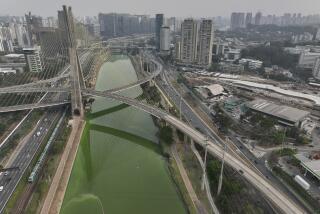Air Pollution Is Stifling Precipitation, Study Finds
- Share via
Pollutants that waft from major industries are stifling precipitation in many regions of the world, in some cases eliminating almost all rain and snow produced by clouds, according to a new, multinational study by atmospheric scientists published today.
For decades, scientists have debated whether urban air pollution can alter a region’s rainfall. The new study, for the first time, seems to provide direct evidence that tiny particles in industrial pollution cause physical changes in clouds that prevent water from condensing into raindrops and snowflakes,
Daniel Rosenfeld, an atmospheric scientist at Hebrew University of Jerusalem, said his research “shows unambiguously that air pollution can shut off precipitation completely from certain types of clouds.” The results, reported in the journal Science, “might indicate that human activity may be altering clouds and natural precipitation on a global scale,” he said.
Because numerous factors can influence precipitation, documenting pollution’s effect on overall rainfall levels remains difficult. But Rosenfeld said he has shown that weather changes can spread hundreds of miles downwind of a large industry’s plume of pollution.
The scientist tracked pollutants from a coal-burning power plant in remote Australia, factories in Turkey and a smelter in Canada.
Many questions remain about how pollution affects rain and snow around the globe, especially because some previous studies have indicated that it might have the opposite effect of increasing rainfall. But Owen Toon, a University of Colorado scientist, wrote in an accompanying article in Science that the pollution plumes in the study will “serve as a Rosetta stone for the potential impact” in more urbanized and industrialized areas, where pollution sources are ubiquitous.
In the study, satellite images were used for the first time to simultaneously track pollution and measure the precipitation and structure of clouds over large expanses of sky. In the past, scientists used airplanes to probe individual clouds.
Rosenfeld reported that it is a physical process, rather than a chemical one, that blocks formation of rain and snow. Industrial plants spew particles, formed by fuel combustion, that are much smaller than the water droplets normally found in clouds.
The small pollution particles inhibit the cloud’s water droplets from coalescing into larger drops to create rain. Smaller water droplets are also slower to freeze, reducing the ice particles in clouds.
In types of clouds that are short-lived, the lack of larger droplets reduces or even eliminates precipitation, the report says.
“Since the 1970s, people have been looking for the smoking gun to back up this theory, and it sounds like he may have found it,” said Stephen E. Schwartz, an atmospheric scientist at Brookhaven National Laboratory in New York. “It sounds like [Rosenfeld] has a nice, clean case.”
Experts do not know what, if any, impact pollution is having on rain and snow in the United States or other urbanized countries, where most clouds are polluted to some degree. If there is an impact, it could have serious consequences in Southern California, where the air contains high levels of particulate pollution, and water derived from rain and snow is scarce.
In the Los Angeles area, the types of clouds likely to be altered by pollution are ones of “modest depth,” Rosenfeld said, “that come from the west in typical winter days characterized by intermittent, moderate rain showers.”
Rosenfeld said he cannot speculate on what his findings may mean for areas like California, where there are no large smelters or coal-burning plants. But he said: “It does not take a very large level of pollution, by health standards, to affect the clouds to producing smaller droplets.”
The tiny size of the particles in the pollution seems to be the most important factor in inhibiting rain and snow. Most of the fine particles in the Los Angeles region’s air come from trucks and cars, not heavy industries.
The most striking plumes of pollution in the study were in southern Australia, home to the world’s largest lead smelter, mineral-processing plants and a large coal-burning power plant. The pollutants there were easy to track because the area has fairly pristine, blue skies. Rosenfeld found that polluted clouds were producing hardly any raindrops and ice crystals, while unpolluted clouds did produce them.
Scientists have long speculated about the impact of urban and industrial air pollution on rainfall and snow patterns. Some had thought particle pollution inhibits precipitation, similar to what happens with smoke from forest fires. But some scientists recently have reported the opposite--increased rainfall--downwind of some paper mills and over some urban areas.
Barbara Finlayson-Pitts, an atmospheric chemist at UC Irvine, was surprised by Rosenfeld’s findings. She said nearly all evidence recently has indicated that pollution from ships and other sources could increase precipitation.
The new study differs, though, because it actually tracked pollutants and studied clouds over large areas.
If pollution is actually stifling rainfall, why have scientists studying specific areas been unable to document any correlations between urban pollution and overall precipitation? Rosenfeld said it may be because urban areas are inflicting other changes in clouds, too, that could offset the effects of pollution. For example, a power plant generates heat that could make clouds grow larger in the immediate area than they would naturally.
“There are a lot of subtleties responsible for whether we get rain or not,” Schwartz said.
Rosenfeld said the rain-reducing effects of pollutants are often strongest many miles downwind of industries, so it has been difficult to pinpoint a cause and effect.
“At least now,” with the new satellite images, he said, “we have evidence that pollution can suppress precipitation.” The next step, he said, is quantifying how big of an effect the pollution is having.
Environmental regulators, especially in California, have recently begun focusing on cleaning up particle pollution, which in the Los Angeles Basin comes largely from diesel vehicles. The push for new regulations, which has been controversial because of the high cost, has been driven by concerns about lung disease and public health, not weather.






